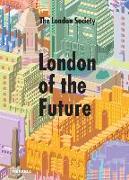- Start
- London of the Future
London of the Future
Angebote / Angebote:
The proposals in London of the Future aim to predict and prescribe how the metropolis might be governed, organized, and designed in years to come and to provoke debate among planners, architects, and developers not only in London but in all major cities throughout the world.Over the course of eighteen essays, experts in various fields - urbanism, architecture, engineering, manufacturing, futurology, journalism, and more - examine possibilities for reimagining and improving many aspects of the city. These writers consider changes both radical and minor that could shape London into a more resilient city and a fairer, healthier place to live. The architectural commentator Peter Murray provides an engaging introduction. Discussing some of the more interesting and, in some cases, eccentric proposals of the earlier book, he paves the way for an entirely new and up-to-date collection of ideas for the twenty-first century and beyond.The architectural critic and consultant Hugh Pearman ponders the dangers and uses of prediction while proposing that London be improved and made more liveable, rather than expanded and developed. The architect Carolyn Steel continues the focus on making the city a more pleasant place to live by discussing the future of its food supplies, considering the place of farming within the city's boundaries to spearhead urban renewal in a newly environmental age. The engineer Roma Agrawal advocates increasing cross-disciplinary understanding in the building and engineering world so that tomorrow's engineers can be curious without boundaries. Yvonne Farrell and Shelley McNamara of the architectural practice Grafton interrogate the meaning of permanence, and what London's inhabitants will need from their buildings.Urbanist Kat Hanna discusses the future of two of London's identities: the Central Business District and the Financial Services Hub.Mark Brearley, an architect and proprietor of a long-established London manufacturer, writes on the subject of the local high street and how the city is strengthened by these social, commercial hubs. Gillian Darley, a writer and historian, looks at the future of heritage and how the city's past can be conserved and contribute towards its future. Sarah Ichioka is an environmental and social consultant, and her approach focuses on the climate emergency and natural solutions to make the city more resilient. The architect Indy Johar puts forward radical ideas about the shift that is required of all London's inhabitants if the city is to transform itself for the future. Smith Mordak, an architect and engineer with Buro Happold, advocates for large infrastructural changes for sustainability. The cultural practitioner and writer Yasmin Jones-Henry, meanwhile, advocates for the value of cultural activities, powered by diversity.The theatre director Jude Kelly calls for London's broadly inclusive cultural past to be put at the center of future plans and imagines a place for AI in that future. Dame Baroness Lawrence, a campaigner who has promoted reforms in the police service, uses housing, education, policing, and racial equality to put forward her vision for a more equitable London. The journalist Anna Minton sets the extraordinarily high values of property in certain areas of the city against a crisis of social housing and the poor quality of low-income housing and asks how the problem of housing inequality can be solved.The architect Claire Bennie also examines how housing can be made fairer and available to more people. The futurologist Mark Stevenson imagines a commercial, building-focused solution to the problem of climate change.The journalist Tony Travers imagines London's future in relation to its survival of past crises. Neal Shashore, an architectural historian, focuses on the approach to educating future designers of the capital, to champion inclusivity and focus on the needs of people and communities.
Folgt in ca. 15 Arbeitstagen
